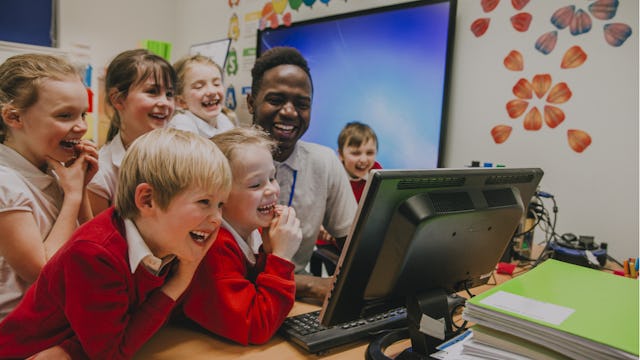Schools Are Trending Toward Project-Based Learning, And It's A Good Thing

It’s no surprise that if you walk into a modern classroom today, you’re likely to see a well-orchestrated cacophony of action going on. Of course, there will be kids at desks using paper and pencil, but there will also be kids cooperatively working on laptops and tablets, using all forms of today’s advanced media and technology to engage their brains and effectively spark the learning process.
Gone are the days when you had to actually take a bus to experience a field trip or depend on snail mail to exchange ideas and experiences with school children on the other side of the planet. Today, they’re replaced with real-world experiences and collaboration happening right in the palm of a student’s hand, and with that comes great opportunity for a different kind of teacher-led instruction — one that is actually not teacher-led, but instead is teacher-moderated. It’s called “project-based learning,” or PBL, and though it’s been around since the early 20th century, it’s enjoying renewed interest as schools continue to experiment with alternative learning processes.
PBL expands on the popular educational theory that students learn best by experiencing real-world problems and working together to find solutions. This goes against the traditional “teach a unit, then administer a test on it” method, which educators have long since known doesn’t truly reach every student, nor is the material successfully retained a majority of the time.
Buck Institute of Education (BIE) defines project-based learning as “a systematic teaching method that engages students in learning knowledge and skills through an extended inquiry process structured around complex, authentic questions and carefully designed products and tasks.”
PBL is more than assigning a short-term group project to small groups in the classroom. It is a more learner-centered and long-term type of instruction, where students are given the chance to have more autonomy over what they learn rather than being directed straight through a generic lesson plan. It requires students to use a multitude of disciplines simultaneously, research collaboratively, and develop a solution, product, service, or specific outcome to an assigned problem.
Assistant School Superintendent Dr. Kerry Clery of Westford school district, which is piloting PBL in its schools this fall, explains it well: “The project could take days, weeks or months, and there is an intentional connection to grade-specific learning frameworks.”
With PBL, projects are not assigned after the student has learned a concept, i.e., a diorama of a state after a lengthy unit on states and capitals. Rather, they are assigned before learning the concept. It’s in the process that the learning takes places. Clery states, “The children work together and they go through quite a process where the learning occurs throughout that time. Teachers start with a pitch or challenge, and the The project-based units are based on real-world problems so students are never saying, ‘Why do I need to know this?’”
Here are some additional reasons why the Buck Institute has stated that PBL is “an effective and enjoyable way to learn and develop deeper learning competencies required for success in college, career, and civic life”:
PBL makes school more engaging. At a time when most students describe classrooms as boring, this is important.
PBL builds success skills for college, career, and life. It ensures students learn how to take initiative and responsibility, build their confidence, solve problems, work in teams, communicate ideas, and manage themselves more effectively.
PBL connects students and schools with communities and the real world. Projects enable students to solve problems and address issues important to them, their communities, and the world. Students learn how to interact with adults and organizations, are exposed to workplaces and adult jobs, and can develop career interests. Parents and community members can also be involved in projects.
PBL promotes educational equity. All students deserve PBL, since a great project can have a powerful effect and help them reach their potential and can even be transformative. A project that makes a real-world impact can give students a sense of agency and purpose; they see that they can make a difference in their community and the world beyond it.
If your school will be implementing PBL soon, Sam Houston State University has a great guide for parents on how to support PBL, what kind of learning outcomes you can expect, and how you can get involved with the process.